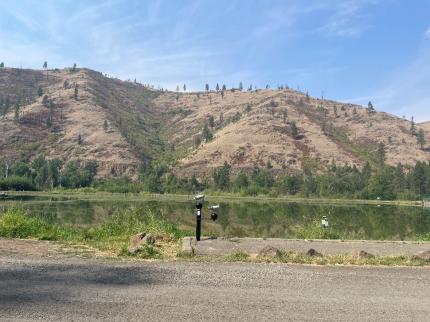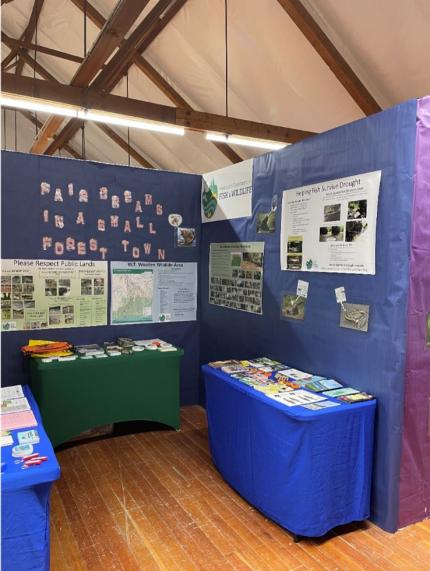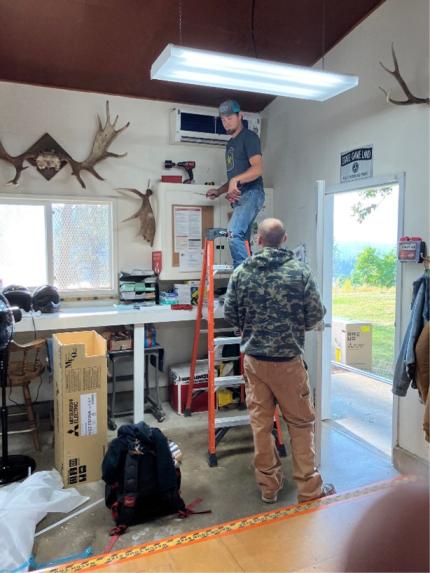Managing Wildlife Populations
Bighorn Sheep Monitoring: District Biologist Wik and Assistant District Biologist Vekasy traveled to Oregon to recover a bighorn sheep collar that had sent a mortality alert. The collar on a yearling ram was shed on a fence line. Placement of collars on older lambs, particularly rams, has yielded important new information on dispersal movements, highlighting an increased risk of contact with domestic sheep. Multiple rams have now traveled through domestic sheep grazing allotments that had previously not been recognized as being in bighorn sheep range.
Upland Game Birds: Biologist Brinkman recorded observations of upland game birds while conducting deer surveys and submitted these observations as part of a larger scale effort to document breeding productivity of upland birds statewide.

Elk Calf Survival Study: Scientific Technician Moberg continued monitoring collared elk calves in the Blue Mountains. She conducted five mortality investigations, of which three were shed collars caught on fence lines and two were likely cougar predations. Field necropsies on carcasses, along with predator DNA sampling, help to support predation evidence.
Habitat Development Activities: Biologist Baarstad contacted seed vendors, co-workers, and volunteers to begin planning fall habitat development work. Several projects are planned for implementation over the next two months.
Deer Surveys: Biologists Lowe and Brinkman conducted deer pre-hunt ground surveys that will be used to estimate buck to doe ratios for white-tailed deer in District 2. These surveys are conducted for around two to three hours in the morning or evening when deer are most active, and the surveys consist of driving routes through different parts of the district and recording the number of individuals and composition of each group of deer observed (i.e., how many does, fawns, and bucks). Mule deer are often encountered during these surveys, and composition of these groups are also documented.


Chronic Wasting Disease: Acting Private Lands Biologist Nizer took Chronic Wasting Disease (CWD) samples to the Spokane regional office for processing. Nizer also checked Department of Transportation pits for deer carcasses. Nizer also checked in with Pacific Pride/Java Bloom to ensure having a check station at that site would still be ok this fall.
Private Lands Biologist Hadley worked with W. T. Wooten Wildlife Area Wildlife Area Manager Dingman to create a CWD poster for the Rainwater Wildlife Area to be put out for hunters to see. Private Lands Biologist Hadley printed and laminated several posters and coordinated to meet with Dingman next week.
Chronic Wasting Disease Operations: Natural Resource Technician Heitstuman checked local pits for CWD samples. Several road-killed deer were also recovered and disposed of due to advanced decomposition.
Providing Recreation Opportunities
Fire Damage: The Gray Fire, which started late in the week west of Spokane, swept through the West Medical Lake Access Area and burned down the fiberglass toilets. This occurred when Dziekan and Brant were off for the weekend. They may be unable to closely inspect the site until the fire is completely extinguished. Swanson Lake Wildlife Area Manager Finch will be working with Dziekan to fill out the damage report and complete follow-up work, including replacing restrooms and posting signage onsite and online. Statewide Access Area Manager Belson and Sherman Creek Wildlife Area Manager Anderson will assist as needed.
Badger Lake Gate: Access Manager Dziekan removed half of the gate at Badger Lake last spring and brought it back to the shop to reinforce it with some new welds. The gate is perfectly functional, but adding additional metal should prevent unauthorized access to the boat launch area when the gate is locked for the season. There have been issues with vandals cutting the lock off the gate so they could get into the access area. Dziekan covered the top of the gate with a new round plate and added some more metal to the sides as an extra measure. The bottom is still open, it needs to be open to allow access the lock, but there isn’t enough room at the bottom to open bolt cutters and cut the lock hasp. It was tested in the field before it was secured.

Tucannon Lakes: Natural Resource Technicians Tritt and Jensen continued checking the lakes and fish screens to make sure everything is working properly. They cleaned up trash around the lakes and cut trees down in the Blue Lake overflow area. Tritt and Jensen completed installation of the new spotting scope at the ADA accessible pad at Rainbow Lake. They used the tractor to move some large boulders to protect the spotting scope from being backed into.



Turnbull Hunt By Reservation: Acting Private Lands Biologist Nizer and Natural Resources Technician Rumiser met with the Turnbull Wildlife Refuge manager to post hunt by reservation and boundary signs for the new 1,883 turkey access site. While posting the property Nizer and Rumiser stumbled across a bull moose. This access site will provide great access for turkey in the future and for viewing beautiful wildlife.

Cummings Creek Road: Wildlife Area Manager Dingman and Natural Resource Technician Tritt took the all-terrain vehicles to check Cummings Creek Road. There are several places where the trees are leaning over the road, making it difficult for horseback riders. Completing clearing of the road is a priority before the upcoming hunting seasons.
Landowner Hunting Permit Application: Acting Private Lands Biologist Nizer worked with Columbia Plateau Wildlife Management Association to submit their Landowner Hunting Permit application for the three-year seasons. Nizer also reached out to Officer Copenhaver to see if he would be willing to attend a meeting that they will be having on Sep. 14. This will allow them to get familiar with the officer that covers their area.
Mentored Youth Hunt: Acting Private Lands Biologist Nizer coordinated with Jason Cushman with Pheasants Forever of Spokane to organize the mentored youth hunt on Sep. 16. The sites were reserved for the youth hunt and birds will be held back to release at the designated sites.
Providing Conflict Prevention and Education
Contract Range Rider Check-In: Wildlife Conflict Specialist Kolb conducted a check-in with a contract range rider. Jacobson was also informed of a contract range rider who may be interested in riding in his area of responsibility.
Potential Contract Range Rider Calls: Wildlife Conflict Specialist Wade spoke with two potential range riders and provided them with information regarding the program.
Wolf Activity and producer Contacts Anatone Area: Wildlife Conflict Specialist Wade worked to contact multiple producers to gain access to their private property for wolf related operations this week. Wade worked to inform the District 3 wolf team of private lands access for the operations. Kolb, Natural Resource Technician Heitstuman, and Wade met with an Anatone area producer to deploy a radio activated guard (RAG) box on their property. Heitstuman and Wade returned later in the week to build an enclosure around the RAG box to prevent damage from cattle and wildlife in the area. The RAG box was deployed in response to a confirmed wolf depredation in the pasture. Wade also discussed grazing rotations with another producer who is running out of viable pasture outside of the W139 activity center.

Wolf Depredation: Natural Resource Technician Harris, Wildlife Conflict Specialist Samsill, and Officer Thoma met with a producer to investigate an injured cow that was discovered on a grazing allotment in the Smackout pack territory. Staff members confirmed that the cow was injured during a confirmed wolf depredation event. The cow will stay at the producer’s homeplace for the remainder of the grazing season while it recovers from its injuries.
Conserving Natural Landscapes
Project Proposals: Natural Resource Technician Harris worked on writing proposals for habitat restoration projects to be conducted in 2024. Harris also met with two landowners that were interested in carrying out riparian area restoration projects on their land.
Asotin Creek Boundary Stock Fence: Wildlife Area Manager Dice looked at 1,000 feet of stock fence built by wildlife area staff and University of Idaho interns at Cook Ridge. The fence closed a hole left by the contractor who didn’t finish his job and has now left the area. Dice also locked the gate going into WDFW land at Cook Ridge and posted agency signs. The contractor sent a crew over to finish cleanup work in order to get paid. Their work wasn’t exactly what we were looking for but will have to do.


Medical Lake Gray Fire: The Medical Lake Gray Fire that started on Aug. 18 destroyed several homes also did some damage to WDFW West Medical Lake access area. The fire destroyed four fiberglass outhouses along with countless signs, fences, and several large ponderosa trees will need to be cut down. Access Manager Dziekan used plywood to cover the open toilet pits after removing the outhouse debris over the openings to make the area safer for the public. Dziekan took many photos and documented the damage in a report that was submitted to Wildlife Area Manager Finch.
This week, Budget Analyst Nelson, Camp Engineer Hansen, Dziekan, and Finch met on teams to discuss the damage caused from the Gray Fire and estimate the cost to repair the damage. Nelson will be submitting a funding request soon to cover the damage repairs. Dziekan is also documenting the hours doing cleanup work.


Habitat Proposal: Natural Resource Technician Harris wrote and submitted a funding proposal for a riparian restoration project on the Vetter Farm in Stevens County. Harris met with Biologist Stetson at the project site to discuss the project.
Providing Education and Outreach
Mentored Youth Deer Camp: Wildlife Conflict Specialist Samsill helped to coordinate and plan the upcoming Third Annual Chris Christensen Memorial Youth Deer Camp. The camp will take place at the Sherman Creek Wildlife Area the weekend of Aug. 24 through Aug. 27.
Hunter Education: Wildlife Conflict Specialist Kolb continued coordination throughout the week on hunter education support for future classes.
Chronic Wasting Disease Billboard: Wildlife Biologists Prince and Turnock, Ungulate Research Scientist DeVivo, Access Manager Dziekan, and Chronic Wasting Disease Technician Brant installed a CWD billboard south of Chewelah. The billboard space was provided by the Northeast Washington Wildlife Group and the sign will be in place from now until mid-December.

Northeast Washington Fair: Wildlife Conflict Specialist McCarty managed a booth with Assistant District Biologist Turnock at the Northeast Washington Fair.
Natural Resource Technician Harris staffed the WDFW booth at the Northeast Washington Fair in Colville.
Spokane Interview: Wildlife Conflict Specialist McCarty spoke with a reporter that was experiencing squirrel damage to his potted tomato plants and wanted to write a newspaper article on squirrel damage in urban areas.
Hunter Education: Wildlife Conflict Specialist Kolb contacted newspapers in Walla Walla and Columbia County about up-coming hunter education opportunities in the area in the event the editors want to share the information with their readers.
Another Unauthorized Field Camp: Fish and Wildlife Officer Thoma successfully got a set of unauthorized residence campers on the western end of Sherman Creek Wildlife Area to clean up and leave their site last week. Wildlife Area Assistant Manager Palmer spotted a new camp, near the previous one along the south fork of Sherman Creek. This new camp appeared to belong to a single person but was unoccupied and in disarray. Palmer cleaned up the site and threw the debris in the dumpster at Sherman Creek Wildlife Area headquarters.
Columbia County Fair Booth: Wildlife Area Manager Dingman and Fish Manager Trump put the WDFW Fair booth together.




Conducting Business Operations and Policy
Lethal Removal Recommendation: Wildlife Conflict Supervisor McCanna spent a considerable amount of time writing the WA-139 wolf group lethal removal recommendation. The District 3 wolf team provided edits and comments. McCanna worked with the Attorney General office for final edits and comments. McCanna sent final recommendation to Region 1 Director Kuttel and Director Susewind.
The Sherman Creek Wildlife Area office received a new heat pump heating and cooling system on Friday. This replaces an old electric baseboard for heat and opened windows and a fan for cooling.


After Action Review: Wildlife Conflict Supervisor McCanna facilitated an after action review after a depredation in District 3. The cause of death was non-depredation.
Wildlife Conflict Supervisor McCanna facilitated an after action review for the WA-139 group recommendation and lethal removal operation. Notes from the meeting can be found at After Action Review.